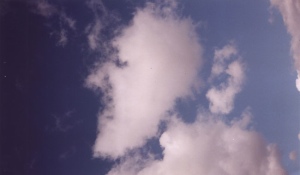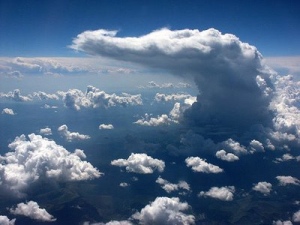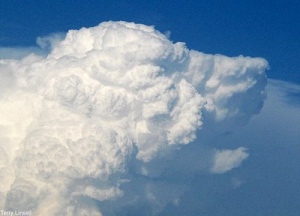
This post probably is what it contemplates. I’ve been thinking about clouds, not as in utility computing, but rather as a metaphor. The cloud is a figure of speech that has worked its way into conversations and trains of thought with increasing frequency. As I attempt to draw a circle around it, the boundaries that I posit seem solid enough. But then, with the flow of time, they start to shift, and then, form into completely different shapes.

For a long time I’ve visualized the tweets emitted from the people I follow on Twitter as a cloud. While the interface represents them as a single-file stream, I see them as emerging simultaneously into a cloud of information. I see them as a cloud because I don’t know in advance what value they have. I don’t know where the edges are, the shapes that emerge are temporary, they must be grasped in the moment. One aspect of the information overload problem is the moment when I sense that the cloud is filled with important information, but I can’t seem to get my hands on it. Other times I can look at the cloud and see that there’s nothing there.

Talking with Phil Windley over dinner at the recent IIW, we began discussing the clouds of information that form around transactions. In the corporate world this is called business intelligence. Systems are built and deployed to capture the data that feeds the cloud of information around management actions. Phil’s work with Action Cards can be viewed as agents/apps that monitor the cloud around a person’s browsing activity (augmented reality) and trigger specific actions when certain conditions are present. Craig Burton might call that changing cloud of information the context. The hard boundaries among web sites at the name/security space level have never been able to contain the information cloud. It travels with the user, unimpeded, on the other side of the glass.

There’s a book that was written in the 14th century by an anonymous cleric called The Cloud of Unknowing. Perhaps it’s more the poetry of the title, than the actual text that has stuck with me. Wikipedia condenses its teachings as follows:
“And so I urge you, go after experience rather than knowledge. On account of pride, knowledge may often deceive you, but this gentle, loving affection will not deceive you. Knowledge tends to breed conceit, but love builds. Knowledge is full of labor, but love, full of rest.”
Even at this early moment, there’s a clear divide between—and subtle understanding of—the human gesture and the schemas of knowledge/information.
- Johnson and Eno in Conversation: Eno-Johnson
Listening to a recording of a conversation between Stephen B. Johnson and Brian Eno at the Institute for Contemporary Arts, the discussion moves to the work of Cornelius Cardew and Paragraph 7 of his work called The Great Learning. Here are some of the instructions for the work:
Paragraph 7, the final paragraph in terms of score order (but with a completion date of 8 April 1969), consists of twenty-four lines which must be sung for the length of a breath a given number of times. Each performer works at his or her own speed through the material in a ‘network’ effect noted by Michael Nyman. This network effect has caught the attention of some writers outside of the immediate British experimental group (for instance, Linda Dusman and Joseph Rukshan Fonseka) more than the rest of The Great Learning.
Eno describes how the sound and shape of the work changes as each performer starts from a self-selected note and when a line is completed, switches to a note they can hear. The piece moves from a dissonant cloud of sound, to a complex chord, to a less complex chord.
Something about this form of sociological composition with a very simple rule set ties directly to the information overload problem in the micromessaging sphere.
Marshall McLuhan put it this way:
Faced with information overload, we have no alternative but pattern-recognition.
This sense of the cloud emerges when the number of things in front of us are too many to count. The things vaporize and form clouds. Here we move up the stack and relate to patterns instead of individual things. The user interface presents us with large set of streams, sequenced items– but the patterns emerge from the overall cloud of information not from the columns of streams flowing through our screens.
But even before we begin to see patterns, we intuit the disposition of the cloud. We sense its energy, speed and direction; its density, the quality of its make up. We’re all meteorologists of the information environment. And while it may be quite difficult to predict whether it’s going to rain or not, you don’t need a weatherman to know which way the wind blows. These clouds of information are forming around every transaction in our lives. But having the data and knowing what to do with it are two separate things. We seem to be at the edge, crossing a boundary line— our hands grasp for clouds, and for the first time, seem to have a hold of something…
